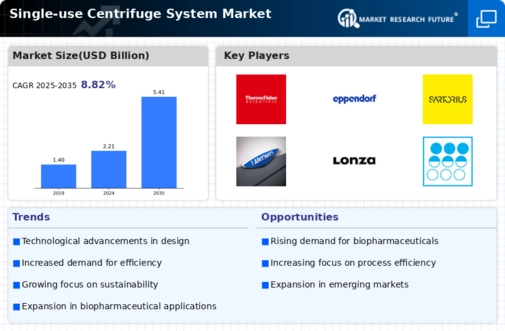Market Growth Projections
The Global Single-use Centrifuge System Market Industry is poised for substantial growth, with projections indicating a rise from 2.21 USD Billion in 2024 to 5.41 USD Billion by 2035. This growth trajectory reflects a compound annual growth rate of 8.49% from 2025 to 2035. The increasing adoption of single-use technologies across various sectors, particularly in biopharmaceutical manufacturing, is a key driver of this expansion. As companies continue to prioritize efficiency, safety, and cost-effectiveness, the market is likely to witness significant advancements and innovations in single-use centrifuge systems.
Rising Demand for Biopharmaceuticals
The increasing demand for biopharmaceuticals is a significant driver for the Global Single-use Centrifuge System Market Industry. As the biopharmaceutical sector continues to expand, driven by advancements in drug development and personalized medicine, the need for efficient and scalable production processes becomes paramount. Single-use centrifuge systems offer flexibility and reduced contamination risks, making them ideal for biopharmaceutical manufacturing. In 2024, the market is projected to reach 2.21 USD Billion, reflecting the industry's shift towards single-use technologies that enhance operational efficiency and reduce costs.
Growing Focus on Process Optimization
The growing emphasis on process optimization within the biopharmaceutical industry is influencing the Global Single-use Centrifuge System Market Industry. Companies are actively seeking ways to enhance productivity and reduce time-to-market for their products. Single-use centrifuge systems facilitate streamlined workflows and faster turnaround times, aligning with the industry's goals for efficiency. As organizations prioritize optimization strategies, the demand for single-use technologies is expected to rise. This trend is anticipated to contribute to the market's expansion, with projections indicating a growth trajectory towards 5.41 USD Billion by 2035.
Cost-effectiveness of Single-use Systems
The cost-effectiveness of single-use systems is a compelling factor driving the Global Single-use Centrifuge System Market Industry. By eliminating the need for cleaning and sterilization, single-use centrifuge systems significantly reduce operational costs and time. This financial advantage is particularly appealing to small and medium-sized enterprises that may lack the resources for extensive cleaning protocols. As companies increasingly recognize the long-term savings associated with single-use technologies, the market is likely to experience robust growth. The projected market value of 2.21 USD Billion in 2024 underscores the financial viability of adopting these systems.
Regulatory Support for Single-use Technologies
Regulatory bodies are increasingly endorsing single-use technologies, which is a crucial driver for the Global Single-use Centrifuge System Market Industry. Agencies such as the FDA and EMA have established guidelines that favor the use of single-use systems due to their potential to minimize contamination risks and streamline manufacturing processes. This regulatory support encourages biopharmaceutical companies to adopt single-use centrifuge systems, thereby enhancing market growth. The favorable regulatory landscape is expected to contribute to a compound annual growth rate of 8.49% from 2025 to 2035, as companies seek compliance and efficiency.
Technological Advancements in Centrifuge Systems
Technological innovations in centrifuge systems are propelling the Global Single-use Centrifuge System Market Industry forward. Enhanced automation, improved design, and integration with digital technologies are making these systems more efficient and user-friendly. For instance, advancements in real-time monitoring and control systems allow for better process optimization and data management. These innovations not only improve product yield but also reduce operational downtime. As a result, the market is expected to grow significantly, with projections indicating a rise to 5.41 USD Billion by 2035, driven by the adoption of cutting-edge technologies.






















Leave a Comment